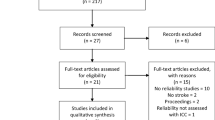Abstract
The use of outcome measures (OMs) in clinical practice has become increasingly important, due to the expectations to account for patient outcomes and justify healthcare expenditures. With the ability to assess patients’ current status and change over time, OMs can inform clinical decision-making and help clinicians and patients better understand their current function and projected recovery. When assessing outcomes, there are five key considerations for clinicians: confidence in a measured value; the extent to which valid inferences can be drawn from a measured value; the extent to which valid inferences concerning a patient’s change status can be made; the patient specific target value; and the ideal reassessment interval. The purpose of this paper is to provide a guide to help clinicians to choose and effectively utilize OMs. We will address the five important application questions to consider, illustrated with clinical examples using the 6-min walk test in different patient populations.

Similar content being viewed by others
References
References of particular interest, published recently, have been highlighted as: •• Of major importance
Abrams D, Davidson M, Harrick J, Harcourt P, Zylinski M, Clancy J. Monitoring the change: current trends in outcome measure usage in physiotherapy. Man Ther. 2006;11:46–53.
Duncan E, Murray J. The barriers and facilitators to routine outcome measurement by allied health professionals in practice: a systematic review. BMC Health Serv Res. 2012;12:96. doi:10.1186/1472-6963-12-96.
Salbach N, Guilcher S, Jaglal S. Physical therapists’ perceptions and use of standardized assessments of walking ability post-stroke. J Rehabil Med. 2011;43:543–9.
Binkley J, Stratford P, Lott S, Riddle D, Network TNAORR. The Lower Extremity Functional Scale (LEFS): scale development, measurement properties, and clinical application. Phys Ther. 1999;79(4):371–83.
Steffen T, Hacker T, Mollinger L. Age- and gender-related test performance in community-dwelling elderly people: six-minute walk test, berg balance scale, timed up & go test, and gait speeds. Phys Ther. 2002;82(2):128–37.
King G, Wright V, Russell D. Understanding paediatric rehabilitation therapists’ lack of use of outcome measures. Disabili Rehabil. 2011;33:2662–71.
Jette D, Halbert J, Iverson C, Micelli E, Shah P. Use of standardized outcome measures in physical therapist practice: perceptions and applications. Phys Ther. 2009;89:125–35.
Copeland J, Taylor W, Dean S. Factors influencing the use of outcome measures for patients with low back pain: a survey of New Zealand physical therapists. Phys Ther. 2008;88:1492–505.
•• Riddle D, Stratford P. Is this change real?: Interpreting patient outcomes in physical therapy. Philadelphia: F.A. Davis Company; 2013. This comprehensive text provides an in-depth review of measurement properties. It is clinically relevant and assists clinicians in understanding how to make meaningful use of outcome measures in practice.
Enright P. The six-minute walk test. Respir Care. 2003;48(8):783–5.
Landis J, Koch G. The measurement of observer agreement for categorical data. Biometrics. 1977;33(1):159–74.
Weir JP. Quantifying test-retest reliability using the intraclass correlation coefficient and the SEM. J Strength Cond Res. 2005;19(1):231–40. doi:10.1519/15184.1.
Atkinson G, Nevill AM. Statistical methods for assessing measurement error (reliability) in variables relevant to sports medicine. Sports Med. 1998;26(4):217–38.
Unver B, Kahraman T, Kalkan S, Yuksel E, Karatosun V. Reliability of the six-minute walk test after total hip arthroplasty. Hip Int. 2013;23(6):541–5.
Kennedy D, Stratford P, Wessel J, Gollish J, Penney D. Assessing stability and change of four performance measures: a longitudinal study evaluating outcome following total hip and total knee arthroplasty. BMC Musculoskelet Disord. 2005;6:3. doi:10.1186/1471-2474-6-3.
du Bois R, Weycker D, Albera C, et al. Six-minute-walk test in idiopathic pulmonary fibrosis. Am J Respir Crit Care Med. 2011;182:1231–7.
Bellet R, Adams L, Morris N. The six-minute walk test in outpatient cardiac rehabilitation: validity, reliability, and responsiveness—a systematic review. Physiotherapy. 2012;98:277–86.
Fulk G, Echternach J, Nof L, O’Sullivan S. Clinometric properties of the six-minute walk test in individuals undergoing rehabilitation poststroke. Physiother Theory Pract. 2008;24(3):195–204.
Casillas J-M, Hannequin A, Besson D, et al. Walking tests during the exercise training: specific use for cardiac rehabilitation. Ann Phys Rehabil Med. 2013;56:561–75.
Kristjansdottir A, Ragnarsdottir M, Einarrson M, Torfason B. A comparison of the six-minute walk test and symptom limited graded exercise test for phase II cardiac rehabilitation of older adults. J Geriatr Phys Ther. 2004;27:65–8.
Enright P, Sherrill D. Reference equations for six-minute walk in healthy adults. Am J Respir Crit Care Med. 1998;158:1384–7.
Holland A, Hill C, Rasekaba T, Lee A, Naughton M, McDonald C. Updating the minimal important difference for six-minute walk test in patients with chronic obstructive pulmonary disease. Arch Phys Med Rehabil. 2012;91:221–5.
Stratford P, Riddle D. Assessing the amount of change in an outcome measure is not the same as assessing the importance of change. Physiother Can. 2013;65:244–7.
Balke B. A simple field test for the assessment of physical fitness. Report Civil Aeromedical Research Institute (U.S.). 1963;53:pp 1–8.
Casanova C, Celli B, Barria P, et al. The 6-min walk distance in healthy subjects: reference standards from seven countries. Eur Respir J. 2011;37:150–6.
Ko V, Naylor J, Harris I, Crosbie J, Yeo A. The six-minute walk test is an excellent predictor of functional ambulation after total knee arthroplasty. BMC Musculoskelet Disord. 2013;14:145. doi:10.1186/1471-2474-14-145.
Herridge M, Tansey C, Matte A, et al. Functional disability 5 years after acute respiratory distress syndrome. N Engl J Med. 2011;364(14):1293–304.
Kennedy D, Stratford P, Riddle D, Hanna S, Gollish J. Assessing recovery and establishing prognosis following total knee arthroplasty. Phys Ther. 2008;88:22–32.
Kennedy D, Stratford P, Robarts S, Gollish J. Using outcome measure results to facilitate clinical decisions in the first year after total hip arthroplasty. J Orthop Sports Phys Ther. 2011;41(4):232–9.
Stratford P. Diagnosing patient change: impact of reassessment interval. Physiother Can. 2000;52:225–8.
Author information
Authors and Affiliations
Corresponding author
Additional information
This article is part of the Topical Collection on Outcome Measurement in Rehabilitation.
Rights and permissions
About this article
Cite this article
Reid, J.C., Kho, M.E. & Stratford, P.W. Outcome Measures in Clinical Practice: Five Questions to Consider When Assessing Patient Outcome. Curr Phys Med Rehabil Rep 3, 248–254 (2015). https://doi.org/10.1007/s40141-015-0098-x
Published:
Issue Date:
DOI: https://doi.org/10.1007/s40141-015-0098-x



